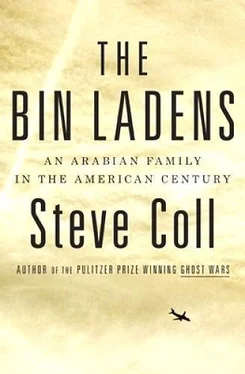Building contracts in Riyadh depended upon the favor of King Abdulaziz. It was easy enough for a man like Bin Laden to connect with the ruler: he could attend his majlis, a daily session in which anyone could sit in the king’s throne room and wait for the chance to petition him for work.
The Riyadh where Bin Laden arrived during the 1930s was still a walled city-fortress similar to those he had known as a boy in Wadi Doan. The Saudis constructed castle-fortresses on their flat desert plateau by encircling the towns with mud-brick walls twenty-five feet high. Palm groves surrounded Riyadh, and townspeople came and went through its gates to harvest timber or collect water during the day. At night and during prayer time the gates closed shut. Riyadh’s wall, wrote Philby, was “surmounted by a fringe of plain shark’s tooth design at frequent intervals. Its continuity is interrupted by imposing bastions and guard-turrets.” Inside, thick-walled houses stacked up on top of one another along twisting lanes, which helped to create shade; there were also market squares, jumbled trading stalls, and, of course, a grand mosque built by the king. 10
Because of his conquest of the Hejaz and his new contracts with American oil companies, Abdulaziz no longer feared that his enemies might raid Riyadh unexpectedly, and so in 1934, he began for the first time to build outside the city walls. He hired a local contractor to oversee a large new family palace compound where the king could hold his majlis sessions, install his new Marconi wireless radios, and accommodate at least some of his enormous family. As his sons married, Abdulaziz added to this construction plan by commissioning homes for them in the new complex. He named his new palace Al-Murabba, or “The Square,” and when it was finally completed in 1939, the main building was an impressive two-story edifice constructed around an open courtyard, where a tall date palm rose to the open sky. The majlis rooms were on the second floor, flanked by rows of offices for the king’s political aides, coffee servers, slave bodyguards, religious scholars, and keepers of the treasury. The entire project, including garages for Abdulaziz’s expanding fleet of automobiles, required the construction of dozens of buildings in a barren region that barely had enough timber to support the population’s daily requirements. The king and his advisers asked their new American friends for materials and construction help, but Aramco and the companies it had invited to Saudi Arabia, led by the Bechtel Corporation of San Francisco, were busy constructing infrastructure for the new oil economy; they did not want to get tied up by the king’s personal palace projects. 11
In this gap Mohamed Bin Laden saw opportunity. He “had a vision,” recalled Mohamed Ashmawi, a friend of the family. “He could foresee you could gain a lot by being helpful to the royalty members, especially the most important ones…He started building homes for some of the royalty.” Exactly when and how Bin Laden first met Abdulaziz is not known, but soon “many royal orders entitled him to establish projects at Riyadh,” according to a Saudi account of his early work. The most important of these was the first palace in Riyadh built entirely from stone; this led to many other contracts in what became known as the Murabba Quarter. Hadhramis, like their more sophisticated Lebanese counterparts, already enjoyed a reputation for entrepreneurialism. They were known as people who would push the limits to get a job done, even if they did not quite know exactly how to do the job in the first place. The plateau around Riyadh is called the Nejd, and the native Nejdis had a saying about Yemeni hustlers like Bin Laden: “If you want him to be a baker, he’ll be a baker; if you want him to be a road builder, he’ll be a road builder.” Bin Laden’s strength in these early days, according to the Saudi historian Fahd Al-Semmari, was that he was “always available…and he would bring many people to do the job. He made many messes but he learned how to do work quickly. If he needed ten people, he would bring one hundred.” 12
Oil royalties had seen Abdulaziz through the Great Depression, if barely. The Second World War, however, shut down international shipping just as Saudi Arabia prepared to deliver its first sizable oil exports. This did not stop the king from building palaces or importing luxuries, but he did not have adequate stores of gold, and he began to run up debts to private merchants. As submarine warfare in the Atlantic and elsewhere crippled British fleets, food supplies to Saudi Arabia grew erratic, and famine haunted its interior desert, where many people lived on the margins even in the best of times.
Churchill’s government had many more pressing priorities, particularly during the war’s desperate early years, but London resumed subsidies to Abdulaziz early in 1940 in order to dissuade him from exploring an alliance with Germany. Britain ultimately gave the king the equivalent of $38 million during the war to keep him loyal; the American government, starting in 1943, contributed an additional $13 million in lend-lease aid. As Germany’s eventual defeat seemed assured, American planners eyed the kingdom as a convenient, uncontested transit point for pushing people and equipment to the Asian front. A top-secret State Department memo to Roosevelt dated December 22, 1944, laid out the case for a new and more committed partnership with Abdulaziz:
A strong and independent Saudi Arabian Government in the Near East…is less likely to fall victim to war-breeding aggression than a weak and disintegrating state vulnerable to economic and political penetration. The vast oil resources of Saudi Arabia, now in American hands…should be safeguarded and developed…The military authorities urgently desire certain facilities in Saudi Arabia for the prosecution of the war, such as the right to construct military airfields… 13
This thinking spurred Roosevelt to meet Abdulaziz aboard the USS Quincy , afloat in the Red Sea, in February 1945. Eight sheep and forty-two courtiers followed the king aboard the American warship. Roosevelt was charming and empathetic; he and Abdulaziz bonded immediately over wonders of the wheelchair, and the president presented one of the latest models to the king as a gift. On the main issues—“oil, God and real estate,” as Rachel Bronson has put it—they also fell into easy, warm agreement. 14
The Americans who began to travel to Riyadh afterward to consult with their new ally found the king admirable, if picaresque and at times puzzling. In the main, they were attracted to his land because, as a secret State Department cable put it, “Saudi Arabia may be likened to an immense aircraft carrier lying athwart a number of the principal air traffic lanes of the world.” 15
Japan’s surrender opened the kingdom’s oil spigot; exports grew from 30,000 barrels per day to 476,000 barrels by 1949. The aging Abdulaziz was now rolling in gold and silver, and he and his sons and advisers embarked on a spending spree. Mohamed Bin Laden returned to Jeddah, summoned by the king’s closest financial adviser, Abdullah Suleiman, who invited him to work on a new royal palace, called Al-Khozam, which the king had decided to build outside of Jeddah’s old city walls, about three miles from the sea. It was a grand two-story coral stone and wood-beam building with twenty-foot ceilings, stained-glass windows, and dual staircases ascending to the majlis rooms on the second floor. Abdulaziz was by now in his late sixties and relied increasingly on his wheelchair. At the Al-Murabba palace in Riyadh, his advisers installed an elevator to lift him to the majlis floor—the problem facing his Jeddah contractors was that the king could not walk with dignity up the grand staircases they had designed. Mohamed Bin Laden helped to invent an ingenious solution: a circular stone ramp that ran from the driveway of the palace up to the second floor. It was wide and sturdy enough so that Abdulaziz could ride in one of his Fords directly into his majlis, descend from the car, and take his throne. 16
Читать дальше












